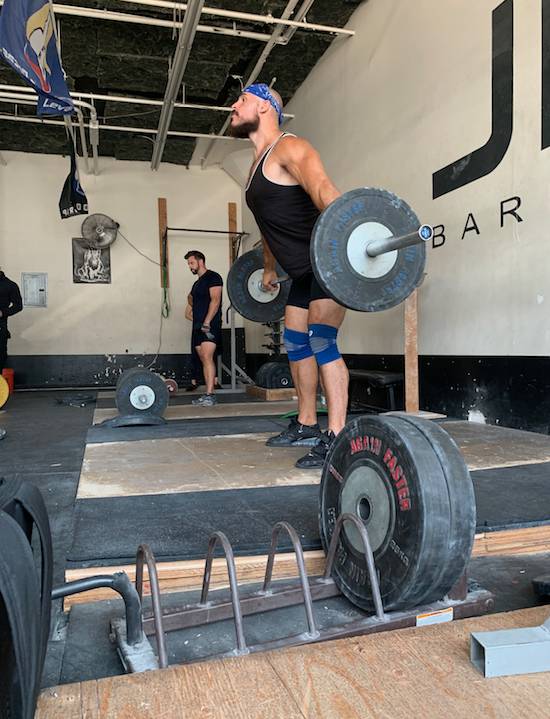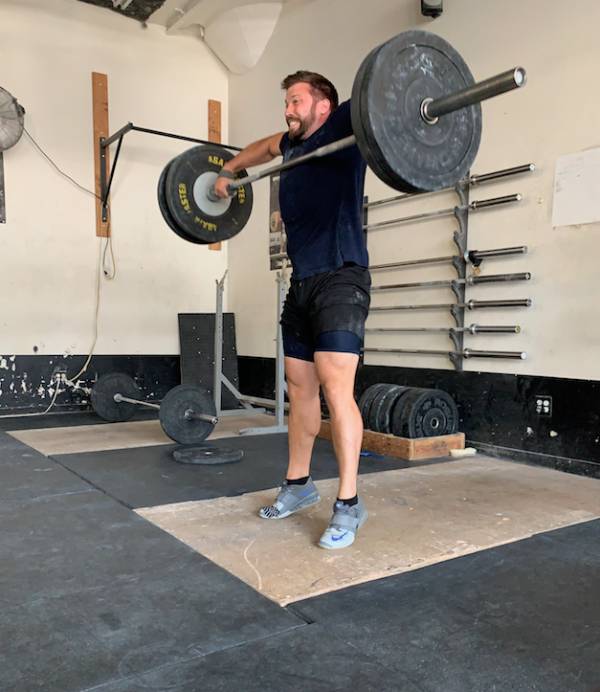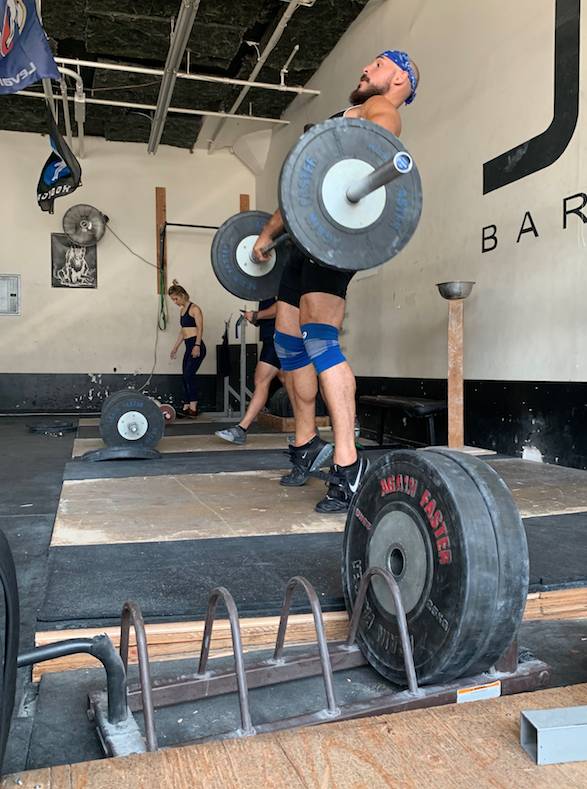Two years ago, Max Aita and I sat down for a beer in a dive bar in Brooklyn, after he taught his first weightlifting clinic at JDI Barbell. We discussed the Olympic weightlifting technique and agreed. Drilling statically the so-called power position has interfered with beginner weightlifter’s progress more than it’s helped.
Two years ago, Max Aita and I sat down for a beer in a dive bar in Brooklyn, after he taught his first weightlifting clinic at JDI Barbell. We discussed the Olympic weightlifting technique and agreed. Drilling statically the so-called power position has interfered with beginner weightlifter’s progress more than it’s helped. He asked me if I knew where the idea of practicing the position came from, and I shook my head as I took another sip of beer.
Max explained that early U.S. coaches decided that this position needed to be taught to beginners and drilled because of still pictures taken of top Olympic weightlifters during competition. When they analyzed the photos, they noticed that all of the lifters seemed to be in the same pull position before going into the final extension.
As the beer slowed my focus, I questioned why a single frame picture of a very dynamic movement was the basis for a method of instruction.
Movement Over Position
A few years back, Russian weightlifters and coaches started touring the U.S. doing seminars at Olympic weightlifting gyms and CrossFit boxes. My friend and weightlifting coach, Yasha Kahn, assisted in many of the workshops, and since he speaks Russian, he could also translate for the lifters who had yet to learn English.
I’ve heard that during one of these seminars, an American coach asked one of the Russians what progressions they used in teaching the lifts. The response was one of confusion. For the most part, the beginner weightlifters that the Russians coached were kids. These kids were singled out because of athletic ability in this sport. They were not adults with different athletic backgrounds or someone who picked up the sport later in life.
Take an athletic kid without mobility restrictions, who hasn’t begun specialization in a different sport, and then demonstrate the snatch and the clean and jerk to them. They’ll be able to imitate the movements with high accuracy, therefore, providing the process by which Russians develop their weightlifters.
Once the young people exhibit adequate fluidity in the movements, the coaches can then re-tool with cue adjustments and drills to build a solid, reliable technique. But the introductory coaching was different than it is in the states, and they practice the movements or segments of them over the positions.
Don’t think of this as an American weightlifting bashing article. Other country’s processes aren’t better; they’re just different. And most of the time when we’re talking about teaching weightlifting in the states, we’re talking about for recreation, not high-level competition. We need to stay focused on that when having this conversation.
Live Actions Matter
At first glance, it makes sense to teach static positions to beginners that an experienced weightlifter moves through during a full lift. But with speed, force, rapid changes of direction and balance, the lifter will not have the same conceptual feel that he or she has when practicing it statically.
I’ll give you a far-out analogy that relates. When exercise physiologists first began looking at human movement and which muscles were responsible for what actions, they examined cadavers. They concluded which muscles performed what work by looking at where they were attached to bones, joints, and body parts.
They weren’t dealing with live humans and seeing the total interconnectivity of the body with all of its electrical impulses, patterns and cross-body stabilizations. They also couldn’t observe how a living person’s body finds ways to increase efficiency and balance. The model was incomplete and didn’t account for live actions.
Learn to Throw
In teaching beginners Olympic weightlifting, we need to understand how to teach explosive movements successfully. If you were to compare weightlifting to other sports, throwing sports would be the most similar in terms of the learning process and practice. The shot put and discus would be the closest, but to keep it simple, we’ll use the example of learning to pitch or throw a baseball.
When you learn to throw a baseball, you learn the steps for the proper wind-up and the appropriate release. Everything between the beginning and the closing happens too quickly for your brain to process immediately.
Over time you develop the ability to think and react so fast that you can practice mid-throw adjustments given by a coach. But, as a beginner, if you keep feeling the wind-up and release in your mind as you learn and practice the throw, your arm will move the ball through an adequate trajectory for this level.
Weightlifting for the Beginner
Learning and practicing weightlifting for the beginner is very similar to throwing a ball. Get a lifter to feel and focus on:
- Proper hip angle
- Balance
- Weight distribution on the feet
- The sequence of firing which muscles
They will lift the bar from the floor in the proper trajectory, and the body will move correctly to guide the bar path.
In weightlifting, the conditional release consists of three different points for the snatch:
- The first point is where the barbell makes contact at the hip before you go into an explosive extension.
- The second point is reversing the bodyweight under the bar after the full extension and pulling the bar to its adequate peak.
- The last point is receiving and fixing the bar overhead before it’s stood up.
The first point is the approximate position labeled as the power position. Looking at a muscle and seeing what joint or bone it acts on in a dead body doesn’t tell the whole story. The static position of a lifter isn’t what the weightlifter should picture in the mind’s eye as they initiate the movement at full speed. The issue becomes how we conceptualize and practice the first release.
Anticipate Change
Because the movement happens too quickly for a beginner to make conscious changes mid-movement, the lifter has to anticipate balance and momentum changes. When you think through high-speed, intricate movement, you can get only a brief glimpse in your mind’s eye of the angle and placement of your body. So if you want to reach a specific position, you have to try to sense the angles and balances right before.
This thinking is why I teach the snatch deadlift and the point of contact of the bar with the hips like this:

Here, the shoulders are in front of the bar. This creates an angle where the hips can open hard, and the contact of the hips with the bar will drive it upwards staying close to the body. Practice the position with the shoulders in front of the bar rather than on top or behind it. The lifter can draw the bar in rather than pushing their hips toward the bar to make contact.
Pushing with their hips will cause incorrect balance and push the bar away from the body after the contact. In this position, the lifter can pull the bar upward if they have the correct foot pressure and balance and lay back slightly as they guide the bar overhead.

If you practice the:
- Angles
- Points of balance and
- Positioning
And then, internalize the feeling when you perform the lift at full speed, the body will open with a natural fluidity into the so-called power position.
And if you take a picture of the position of the high-level lifters at this same point, the photos will look almost identical.
This position happens as part of the natural flow of the movement. Practice and reinforce the pull with an exaggerated posture of the hips flexed and the shoulders over the bar. If a beginner practices and drills the feeling of having the shoulders directly over the bar and the knees already pushed forward and tries to push for this feeling at full speed, this will happen:

They will shift their weight and balance forward to their toes, pushing the bar forward and causing a loop on the bar or away from their body. It is so drastic that they either have to jump ahead with the bar or it comes down in front of them without their shoulders fixed to receive it.
The Mouths of Experience
I didn’t figure out any of this on my own. I struggled with why other lifters or myself would miss behind or jump forward after the bar longer than we should. I understood the idea of balance and keeping weight back and drawing the bar into the hips rather than thrusting the hips forward.
I had no clue that I needed to change my image of the final position before the extension or how to use deadlifts and pulls with this exaggerated angle. I didn’t understand until Yasha Kahn started coaching and reinforcing these ideas to Vasily Polovnikov and me.
The instruction Yasha learned as he got to know all of the Russian coaches and athletes enabled him to be a liaison during their seminars. Vasily received this coaching experience firsthand while on the Russian national team.
When Yasha began re-tooling my movements, he had me practice this position over and over. He used pulls, slow snatches, and other variations until my body internalized the proper positioning and balance for the lift at full speed.
When I teach or learn something new from others, I direct the attention to how the movement should feel, not how we should think of pictures or words.
Jesse competes in the sport of Olympic weightlifting, and he was also formerly a competitive powerlifter. He was featured in main strength and fitness publications. You can read more of his work on his website.






